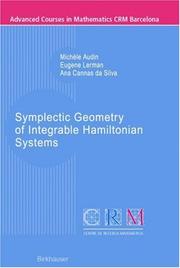| Listing 1 - 2 of 2 |
Sort by
|

ISBN: 1280627751 9786610627752 3764376929 3764376910 Year: 2006 Publisher: Basel ; Boston : Birkhauser Verlag,
Abstract | Keywords | Export | Availability | Bookmark
 Loading...
Loading...Choose an application
- Reference Manager
- EndNote
- RefWorks (Direct export to RefWorks)
This volume has its origins in the Research Programme on Set Theory and its Applications that took place at the Centre de Recerca Matemática (CRM) Barcelona from September 2003 to July 2004. It consists of two parts. The first contains survey papers on some of the mainstream areas of set theory, and the second contains original research papers. The survey papers cover topics as Omega-logic, applications of set theory to lattice theory and Boolean algebras, real-valued measurable cardinals, complexity of sets and relations in continuum theory, weak subsystems of axiomatic set theory, definable versions of large cardinals, and selection theory for open covers of topological spaces. As for the research papers, they range from topics such as the number of near-coherence classes of ultrafilters, the consistency strength of bounded forcing axioms, P_kappalambda combinatorics, some applications of morasses, subgroups of Abelian Polish groups, adding club subsets of omega_2 with finite conditions, the consistency strength of mutual stationarity, and new axioms of set theory.
Set theory --- Research. --- Aggregates --- Classes (Mathematics) --- Ensembles (Mathematics) --- Mathematical sets --- Sets (Mathematics) --- Theory of sets --- Logic, Symbolic and mathematical --- Mathematics --- Logic, Symbolic and mathematical. --- Algebra. --- Combinatorics. --- Mathematical Logic and Foundations. --- Order, Lattices, Ordered Algebraic Structures. --- Combinatorics --- Algebra --- Mathematical analysis --- Algebra of logic --- Logic, Universal --- Mathematical logic --- Symbolic and mathematical logic --- Symbolic logic --- Algebra, Abstract --- Metamathematics --- Syllogism --- Mathematical logic. --- Ordered algebraic structures. --- Algebraic structures, Ordered --- Structures, Ordered algebraic

ISBN: 3764321679 3034880715 9783764321673 Year: 2003 Publisher: Basel: Springer,
Abstract | Keywords | Export | Availability | Bookmark
 Loading...
Loading...Choose an application
- Reference Manager
- EndNote
- RefWorks (Direct export to RefWorks)
Among all the Hamiltonian systems, the integrable ones have special geometric properties; in particular, their solutions are very regular and quasi-periodic. The quasi-periodicity of the solutions of an integrable system is a result of the fact that the system is invariant under a (semi-global) torus action. It is thus natural to investigate the symplectic manifolds that can be endowed with a (global) torus action. This leads to symplectic toric manifolds (Part B of this book). Physics makes a surprising come-back in Part A: to describe Mirror Symmetry, one looks for a special kind of Lagrangian submanifolds and integrable systems, the special Lagrangians. Furthermore, integrable Hamiltonian systems on punctured cotangent bundles are a starting point for the study of contact toric manifolds (Part C of this book).
Differential geometry. Global analysis --- Differential geometry. --- Manifolds (Mathematics). --- Complex manifolds. --- Physics. --- Differential Geometry. --- Manifolds and Cell Complexes (incl. Diff.Topology). --- Mathematical Methods in Physics. --- Natural philosophy --- Philosophy, Natural --- Physical sciences --- Dynamics --- Analytic spaces --- Manifolds (Mathematics) --- Geometry, Differential --- Topology --- Differential geometry
| Listing 1 - 2 of 2 |
Sort by
|

 Search
Search Feedback
Feedback About UniCat
About UniCat  Help
Help News
News